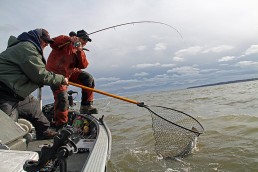Fishing Warm-Water Discharges in Winter
SHARE THIS POST
Warm-water discharges provide open-water angling for a variety of species during the winter months, as MidWest Outdoors editor Dave Csanda explains.
Warm-water discharges at coal-fired and nuclear plants rely on local lake/river/reservoir water to cool their operations, cycling ambient cold water through their system and expelling warmed water back into the local environment. This creates pockets of warmer-than-normal water at the outflow, even during the depths of winter. Baitfish of all species pack into these artificial hot spots, and gamefish of all species follow.
Nearly every state in the Union offers these fishing opportunities in one manner or another. Spend a little time Googling the opportunities in your area, and you’ll likely come up with a few nearby options for an open-water winter fishing trip near home.
Basic principles
Every discharge is different, but the principles are the same. The narrower the flow, and the closer you can legally move your boat into it, the bigger the concentration of fish you’re likely to encounter. The broader the area of influence, the less concentrated the fish will be. The first case is literally like shooting fish in a barrel. The second may mean that schools of fish will be spread out and perhaps passing like flights of ducks or geese—which is still a mighty good proposition.
Where a warm-water flow exits into a large lake or river, the warmer temperatures will dissipate more quickly. Even so, make sure to check areas immediately downcurrent or downwind of the source of the flow, where the effects of warming water will remain more pronounced. This is particularly true when fishing for Great Lakes salmon or trout.
Should a warm-water flow exit into a canal, the back of a cove, a harbor or other somewhat restricted area, the entire area may remain free of ice despite frigid winter temperatures. Schools of baitfish and gamefish may roam the entire area. More cover-oriented species like largemouth bass may simply set up on wood or weed cover along the shoreline, waiting for baitfish to pass nearby. Other areas of the lake/reservoir, meanwhile, may be frozen over while the artificially warmer environment remains ice-free and of modest temperature all winter long.
Are you enjoying this post?
You can be among the first to get the latest info on where to go, what to use and how to use it!
Tailor your lures, baits and presentations to whatever species is likely to be biting. It might be baited jigs for walleyes, spoons or crankbaits for trout and salmon, spinnerbaits/cranks/jigs/worms for bass, or cut bait for catfish. You might need to focus your efforts casting or jigging in a tiny spot, or troll a broader area to make fish contact.
Power plants don’t run 24/7/365. At times when they’re not operating, they are less likely to focus fish activity. You may be able to call up the local plant and get a sense of their generating schedule. When plants kick back into gear and power is again being generated, often evidenced by visible smokestack emissions, it’s like flipping a switch.
Rules are rules
After 9/11, security levels skyrocketed around power plants, and today, many discharge areas are posted to restrict access within a certain distance. Observe posted limits as to how closely you can approach a discharge. Even when positioned a distance back from the heart of the warmer flow, you should be able to enjoy access to artificially high concentrations of active fish in open water during winter.
Gain more useful fishing knowledge in every issue of MidWest Outdoors, available by subscribing on our website.
MWO
SHARE THIS POST
You may also like...
Nothing found.
Did you enjoy this post?
You can be among the first to get the latest info on where to go, what to use and how to use it!
Dave Csanda
Dave Csanda has enjoyed 40 years in the fishing communications industry at In-Fisherman, Angling Edge and now, as editor of MidWest Outdoors. He is an inductee of both the Minnesota and National Fresh Water Fishing Halls of Fame.
